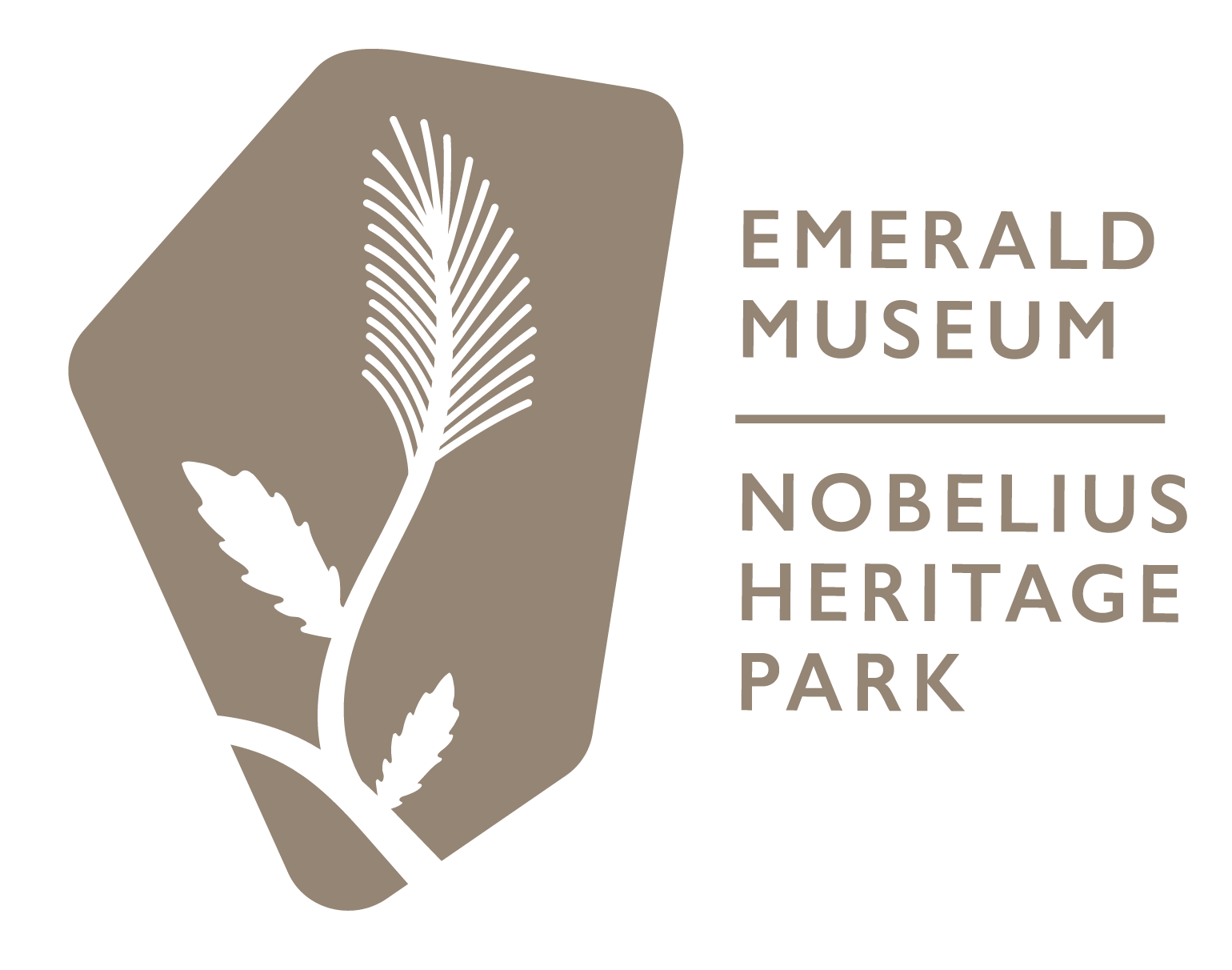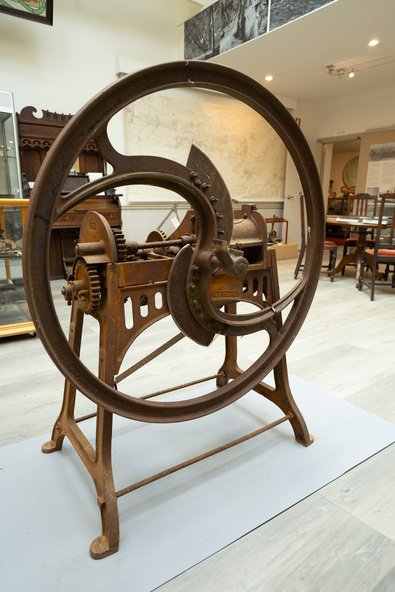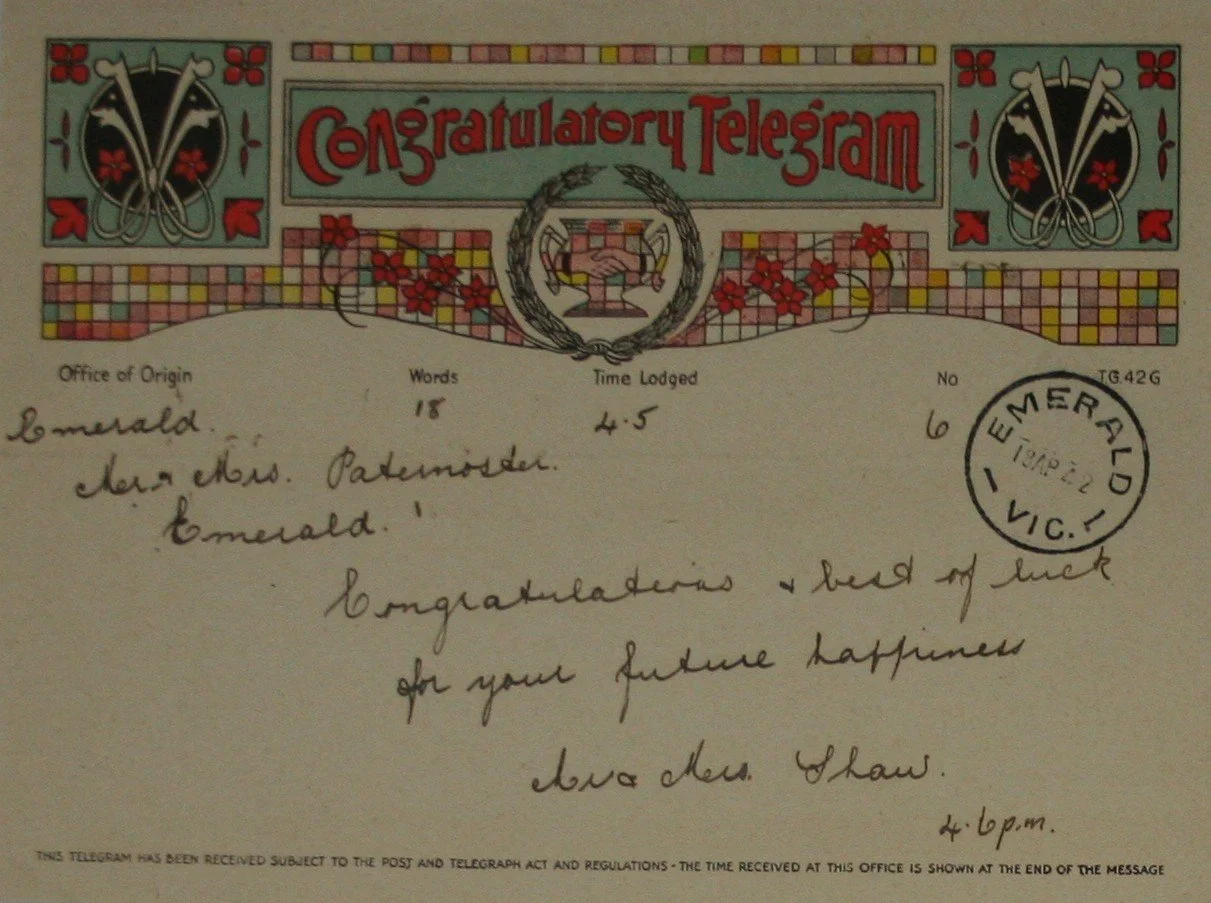Emerald Museum was established as a formal collecting entity in 1969 based at the Emerald Hall, acquiring material by donation from local community members. In 1988 the former Shire of Sherbrooke, with the help of State Government, purchased the only remaining section of the former C. A. Nobelius & Sons Nursery. By the late 1980s the collection had been relocated to a shed on the former nursery. This collection included written records of the nursery’s operations that had been maintained throughout its ownership by the Nobelius family and L. Linton. However in the damp shed, the collection’s condition deteriorated. The nursery records received extensive conservation treatment to restore their condition and are now held as a complete collection at Emerald Museum. After the Emerald community lobbied extensively for a place to house their local heritage, the Shire agreed to construct a purpose-built facility within the former nursery where it has resided since 1993. The land was officially opened as the public ‘Nobelius Heritage Park’ in the same year. The Emerald Museum is an archival repository and display for a wide range of items that relate to the history of the former Gembrook/C. A. Nobelius & Sons Nursery, as well as Emerald and surrounding districts.
The small settlement of Emerald in Victoria’s Dandenong Ranges was established in 1858 when gold was discovered along the Menzies and Sassafras Creeks, causing prospectors to flock to the area. By 1877 large blocks of land in Emerald were surveyed and subdivided from Dandenong State Forest. Many new settlers moved to the area, with some working in the eucalyptus industry, some as bullock drivers, and others running their own farms or orchards. This leather briefcase dating from the 1930s contains a Chesterman Bakelite 100 ft measuring tape, and a bound notebook containing entries related to surveying work undertaken in the Dandenong Ranges.
In 1858 gold was first discovered in the Emerald District, with the richest alluvial gold found at Menzies Creek. Within months over 100 miners set up along the Sassafras, Menzies and Woori Yallock Creeks. A small township grew at the junction of Menzies and Woori Yallock Creeks. It was settled by the prospectors Geraghty, O’Hannigan, Walsh, O’Shannassy, McCrea and McEvoy, all of whom were from Ireland. By the 1960s the rush had petered out but in 1890 there was a second rush which established the larger township we know today. This goldminer's pick dates from the 1800s, and was used on the goldfields.
Prior to settlement the Dandenong Ranges were thickly timbered forests. Timber was the most important early industry in the Dandenongs, including at Emerald. The sale of quality felled timber was one of the first incomes for settlers while they established farms, although some mills, such as that pictured, were relatively small. The settlers used the timber for the construction of dwellings and fences. It was also used for heating water to produce steam, which was one of the main energy sources for local industry.
Early settlement of the district depended on animal power, both bullock and horse. Logs were carried to timber-mills and railway stations by bullock-wagons while essential goods were brought back. This painting depicts George W A'Vard and his bullock team, transporting timber from Olinda to Kallista to be used building his home. Sitting on his mother's lap is George A'Vard as a baby. Early pioneers led bullock teams, usually consisting of eight bullocks, which hauled logs, ploughed and cleared land for agriculture. Early pioneers of Emerald were the leaders of the teams, including Bill Hall, David Charman, Wal Legg, Bill Hermon, and George A’Vard.
Horses were vital in most early farming operations before the invention of tractors. A chaff cutter was used to cut straw or hay into small pieces before being mixed with other forage and fed to horses and cattle. Stalks were fed through a wooden chute at the back of this machine. Turning the wheel operated the gears causing the stalks to be pushed through the rotating blades which cut the stalks to a set length. This chaff cutter was used on a small farm in Emerald which was purchased by C. T. Alexander in 1920, and which has been owned by members of the Alexander family since then.
The steep hillside and rich Emerald soils favoured small, mixed farms, which kept animals such as dairy cows, pigs and sheep and grew a variety of vegetables. Raspberry farms were one of the first agricultural experiments in Emerald, and they soon became a staple crop through the wider district. This homemade water distillation unit came from a local Emerald farm with a history dating back to 1920. The unit was used to remove impurities from water by transforming water into vapor before condensing into a liquid state. Early settlers would often make necessary equipment by improvising with the materials they had to hand.
This ornate ceramic cheese plate and cover which is probably early 20th century was owned by the Ure family. Scottish migrants, John and Jane Ure. They settled on acreage north of Gembrook in 1874 which they called 'Silver Wells' because of finding a pure and plentiful water source when digging their initial well. Silver Wells became the commercial centre of the early Gembrook settlement with shops, post office etc. When the train came through in 1900 the Gembrook commercial centre shifted to its present location, near the railway station. The Ure family continued to play a significant role in the Gembrook community.
In the 1880s mail travelled to Emerald by horseback via Gembrook and then by coach from Narre Warren. The Emerald "loose bag" was dropped at Hultgrens Bridge, Cockatoo then transported to Emerald. The first post office in Emerald was located in Andrew's Store in 1898 and in December 1908 a new building was erected in the main street, where it remained into the twentieth century. This telegram is one of several sent to Miss Myra Sherriff and Mr Henry Paternoster on the occasion of their marriage in April 1942, and was received at and dispensed from the Emerald Post Office.
Carl Axel Nobelius was born in 1851 of Swedish parents, and migrated to Melbourne in 1872. Nobelius trained in horticulture in Sweden and his first employment in Melbourne was as a nursery assistant to a well-known landscaping firm Taylor and Sangster of Toorak. Determined to have his own business, Nobelius set about finding land to establish a nursery. In 1886 he found his way to Emerald where the rich soil was suitable for transplanting his seedlings and young trees. With his savings and a loan from Taylor and Sangster he purchased 63 acres of heavily timbered hilly land around the now Emerald Country Club. By 1914 Nobelius owned the largest nursery in the southern hemisphere. This sales ledger is representative of a nationally significant collection of sales records, wage ledgers and stock catalogues held in the Emerald Museum collection.
During the 1870s pharmacist Joseph Bosisto (1824-1898) established eucalyptus distilleries in Macclesfield, Clematis and Emerald. Bosito became a prominent chemist, inventor and public figure in Melbourne and nationally. His famed oil gained international status and prizes in the late 1890s and continues to be produced to this day. The employees of the Public Parks and Gardens presented this desk set to Bosisto in 1882 as a token of their gratitude. This was most probably because Bosisto had successfully campaigned for gardeners employed at public parks and gardens to receive retirement allowances.
With 450 acres and two million trees, Carl Axel Nobelius conducted a huge export trade to all parts of Australia, and globally. In 1911 Carl Axel Nobelius was producing: 300 different kinds of apples; 61 different kinds of apricots; 78 different kinds of cherries; 31 different kinds of nectarines; 107 different kinds of peaches; 108 different kinds of pears; 122 different kinds of plums; 18 different kinds of quinces; 20 different kinds of figs; 37 different kinds of oranges and lemons; 3 different kinds of medlars; 4 different kinds of mulberries; 39 different kinds of grapes; 16 different kind of raspberries; 12 different kinds of blackberries; 4 different kinds of strawberries; passion vines; lavender; rosemary and 120 different kinds of ornamental trees.
In the 1890s, trees from the Nobelius Nursery were sold to more than forty councils and Government organisations, including the Department of Agriculture, Lands Department and Victorian Railways. The need to transport nursery products by train via Ferntree Gully rather than by bullock dray to Narre Warren was a factor in the successful petition to develop what is now known as the Puffing Billy Railway. Railway developments in 1900 included the creation of a siding and Packing Shed, known as Nobelius Station, which is featured in this photograph. The Packing Shed was able to handle 250,000 cases of fruit each year.
This book of poetry was written by Avonsleigh's Leonard Mann. For almost a century the beauty of the bush and the peaceful hills have attracted writers and artists to the Dandenong Ranges and nearby hills. C.J Dennis, Mrs. Anaeas Gunn, Vance and Nettie Palmer, Katharine Susannah Prichard and Louis Esson were among them. Rose Charman's cottage, built in 1908 and situated on an Emerald hillside, was a gathering place for Australia's literary figures.
In January 1879 the first school in the Emerald District, No. 2110, opened with 25 students, in a rented room on Avon Road. In 1887 the school was described as having “the appearance of a cow yard rather than a State School” because of the adjacent animals. In 1909 the school was closed, and the Emerald State School No. 3381 opened in the Emerald township, and in 1915 an appropriate school was built on Heroes Avenue where it remains today. By 1922 there were 104 students enrolled. When Mr. H Larter became Headmaster in 1934 he began a new curriculum. He organised the upper school (grades 5, 6, 7 and 8) into Green and Gold houses, who competed in sporting and other events for this cup. It was presented to the winning side at the end of each year, and it stood on the shelf above the fireplace in the big room.
This leather saddle was used by Harold Ferres (1885-1978) in the First World War. Ferres enlisted in the Australian Imperial Force in 1915. He spent most of the war in the 58th Battalion. He served as Captain and was awarded the Military Cross, the Bar of the Military Cross and the Distinguished Service Order for gallantry, resolute leadership and courage. His time in the AIF ended in December 1919 with the rank of Major. Her retired as one of the AIF’s most decorated soldiers. After the war he resumed farming on a new property near Emerald, where he died at the age of 92. In total, 32 soldiers from Emerald and surrounding districts lost their lives in World War I.
Five months after war was declared on August 4, 1914, Eric Durance (known as William) enlisted at Broadmeadows, Victoria. William, a 20 year old Macclesfield farmer, had to provide a letter of consent from his widowed mother Margaret. William was assigned to D Company, 22nd Battalion of the Australian Infantry Forces in January 1915. After completing their training in Egypt, the battalion was dispatched to Gallipoli in September 1915. Barely 5 weeks later on October 4th, 1915 William died of gunshot wounds to the head. It was his 21st birthday. He was buried at the Lone Pine Cemetery, Gallipoli. William was awarded the British War Medal 1914-1918, the Victory Medal and the 1914-15 Star. William's personal effects consisting of his identity disc, wallet, belt, knife, letters, photographs, and his damaged wrist watch were returned to his mother.
This long lasting flower arrangement, also known as an immortelle, was originally enclosed in a glass globe and installed on the Nobelius grave at the Emerald Cemetery after the death of Carl Axel Nobelius in 1921. The glass globe was subsequently broken by a falling tree and the immortelle was then removed from the cemetery by relatives in order to protect it. The immortelle consists of three roses, foliage, and a dove attached by wire to a circular metal plate, surrounded by loose flowers.
This iron scoop was pulled by bullocks or horses to carve out cuttings to make permanent roads and dams on small farms throughout the Dandenongs. Emerald Lake was formed using the horse-drawn scoop. During the 1880s the area now known as Emerald Lake Park, 50 hectares, was purchased by Carl Axel Nobelius to form part of his plant nursery holdings. Despite the clearing he undertook in the area, Nobelius preserved elements of the original ecology. After Nobelius' death, the land was sold to William Treganowan. Members of the Nobelius family encouraged him to develop the land around the current lake site as a park. During 1934-1940, a lake of more than 3.5 acres was established, and was named Lake Treganowan. It became a popular swimming destination, and a community hub for the Emerald district.
This Baby Health book belonged to the parents of Jack Charman who was born on 24 September 1944. Jack's weight was recorded at regular intervals from 12 October 1944 until 31 October 1946. The Baby Health Centre was at Ferntree Gully. A small baptismal certificate for Jack Charman was placed inside the Baby Health book. The Charmans were an early Emerald family who, in the 1900s, ran the Brookdale Guest House. The Emerald Baby Health Centre in Belgrave-Gembrook Road supported local mothers in the care of their babies and was officially opened in March 1940.
The Emerald Country Club is of historic and aesthetic significance. It epitomised the American-style country club developments which became popular in the inter-war years. The site, which had originally belonged to the Nobelius Nurseries, was developed in the 1920s and the 1930s as the Emerald Country Club. The clubhouse building was completed in 1929 and was featured in Australian Home Beautiful (February 1930) in an article extolling the virtue of country clubs. The Country Club comprised the Clubhouse, ornamental lake, lakeside rotunda, causeway, semi-circular terrace / turning circle at the front of the Club house, and fairways (originally 9 holes).
After gaining his Medical degree at Melbourne University, Dr Ian “Spud” Macleod Murphy joined the Royal Australian Navy and served on the HMAS Napier as a ship's medical officer. Dr Murphy ran a successful medical practice in Hampton and together with his wife Margaret, retired in 1947 to a property in Edenmont Rd, Clematis. Their intention was to breed turkeys. However, there was no retirement. The community of Emerald and surrounding districts had no doctor, so for the next 34 years, Dr Murphy provided medical care, working seven days a week and travelling all over the hills without any assistance. He was awarded the British Empire Medal in 1977 for his devotion to the health of the community.
Following the opening of the Ferntree Gully to Gembrook Railway in 1900, December 1901 saw the first tourist train operate on the line. The line ran through the “mystical Dandenongs” and the train was embraced and variously known as Little Train, Puffing Gemme and Puffing Billy in the early 1900s. In 1953, Puffing Billy was scheduled to be closed by the Victorian Government following falling passenger numbers and a landslide near Menzies Creek. This photograph is believed to have been taken on one of three special days in December 1954 and January 1955, negotiated by the Herald and Weekly Times for its 'Young Sun' readers before the line was permanently closed. A public campaign to reopen the line ensued, and in 1955 the Puffing Billy Preservation Society formed to restore the line.
The Emerald Football club history dates from 1904, and like many local clubs and organisations, has always played an important role in the community. This trophy was awarded to Geoff "Digger" Dolan of the Emerald Football Club for scoring 15 goals in a single match against the Woori Yallock Club on the 9th of July 1977. The match broke the club record at the time, resulting in 120 goals being scored in 12 matches from the 16th of April to 9th of July 1977. The following year, Dolan achieved a similar feat, kicking 18 goals in a match against Silvan, contributing top their 133 point win. In 1981, Emerald won their season Premiership in which Geoff "Digger" Dolan alongside Terry Gedde, Jim Brennan and George Millman were praised as highlights in the game, contributing to their win after a 25 year drought.
This fire fighting backpack extinguisher, dating from the 1960s, was used for mopping-up and combating small fires by members of a crucial volunteer fire fighting service operating in the Emerald district since 14 March 1941, originally as the Emerald Bush Brigade. The Brigade's equipment was first stored at Madigan's butcher's shop, near the corner of Monbulk Road, until the first fire station was built around 1945. In 1966, this station was recorded as containing the fire truck and a Land Rover pumper, three radio sets, 40 knapsacks, six lengths of hose, helmets, rake hoes and other hand tools. In 2010 the Brigade moved into a new purpose-built facility in Monbulk Road.
This portrait, painted by local artist John Dudley in 1991, depicts Gus Ryberg, a prominent citizen of the Emerald region. Gus was a member of the Emerald Fire Brigade, Emerald Arts Society and the Macclesfield Cemetery Trust, among many other community organisations. He received an Order of Australia medal for services to the local community in 1996. Early in his career, Gus worked for Gembrook Nurseries, which after his retirement led him to lobby for the last section of the land occupied by the nurseries to be formed into a public park with a purpose-built museum, the Emerald & District Museum. Ryberg was responsible for many of the plantings in the resulting Nobelius Heritage Park. After his death, a Canadian Maple was planted in the park in his honour, with an accompanying memorial plaque.



























